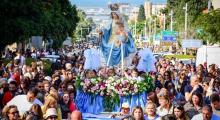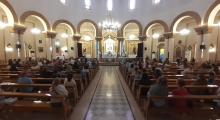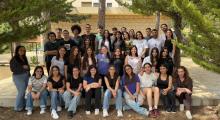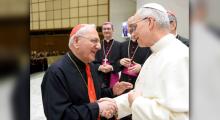Issued by the Catholic Center for Studies and Media - Jordan. Editor-in-chief Fr. Rif'at Bader - موقع أبونا abouna.org
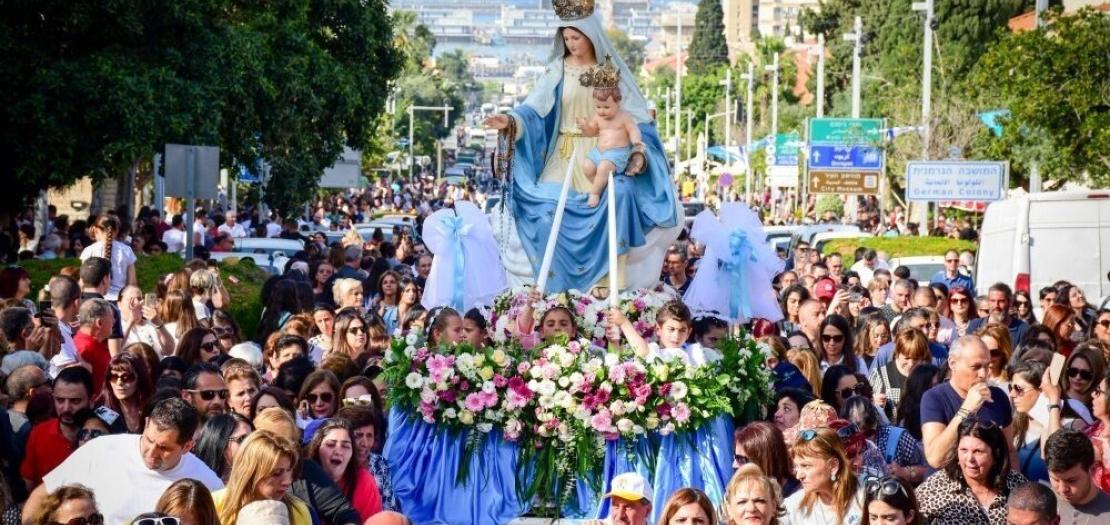
Believers joyfully anticipate the arrival of the month of Mary in May each year. Worshippers flock to churches, visit shrines, and hold regular prayers in their homes, when the “presence” of the Virgin Mary visits a given household, gathering neighbors or villagers to pray and recite the most beautiful prayers written in honor of Mary.
My late mother, an active member of the Maronite Church, always insisted on using the term “the presence of the Virgin” rather than her “statue,” since the “presence” symbolizes focus on Mary’s image or identity, while the term “statue” suggests a return to paganism. Whenever we used the phrase “statue of the Virgin,” we would apologize and correct ourselves.
In Lebanon, and the Middle East in general, many churches are named after the Virgin Mary and attract believers from all denominations, who come from far and wide to pray, seek blessings, and entrust their concerns, worries, and hopes to Her.
She is Mary, Mother of God, and every mother among us is a Mary, for she has given birth to someone created in the image and likeness of God.
Mary’s symbolism is undisputed in both Christianity and Islam, having achieved a historical, timeless consensus. This is why, in Lebanon, the Feast of the Annunciation is considered a national holiday celebrated by all Lebanese, regardless of their respective affiliations. At the Middle East Council of Churches, we have regarded it as a common religious space, among other such spaces, where all believers accept and celebrate together.
The MECC’s common religious spaces program, launched last year, is ongoing, and we look forward to expanding it across the region, where we have found many common religious and social grounds between followers of two faiths who have interacted for fourteen centuries—an interaction rooted in shared religious foundations.
Similarly, Lebanese people are heartened by the sight of believers of different backgrounds visiting places of worship and shrines named after the Virgin Mary.
Whether you visit Harissa, neighboring Bkerke in Mount Lebanon, Our Lady of Maghdouche in South Lebanon, Our Lady of Nourieh Monastery in North Lebanon, the Lady’s Shrine in Zahle, or Our Lady of Saydanaya in Syria, or any church or shrine bearing Mary’s name, you’ll find that the number of non-Christian visitors may equal or even exceed that of Christians.
This shows that ordinary people, in their simplicity and spontaneity, are not sectarian—they respect each other’s religions and even partially embrace them, both in faith and through popular and cultural interaction, which are the result of their common life.
It also indicates that interfaith dialogue, bringing people together, and removing barriers between sects and followers of different beliefs, is within reach if the necessary elements are secured.
Tomorrow’s societies will be extremely diverse and complex due to global migration and mingling. If we, as an institution, fail in strengthening dialogue, especially among the youth, then the whole world risks becoming a project for civil wars.
For this reason, the MECC has developed a dialogue project covering various areas of Lebanon, aiming to entrench a culture of dialogue and nip hate speech and racism in the bud.
We are fully aware that genuine dialogue is the “dialogue of life,” not dialogue of committees sitting behind desks and losing credibility.
In this context, the month of Mary can be seen as a month of dialogue, social solidarity, and true national unity, in addition to its original purpose of prayer and honoring the Virgin Mary, whom God favored above all women.



